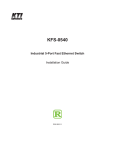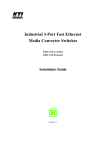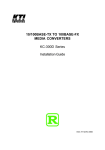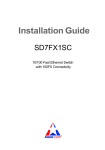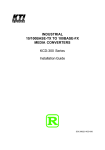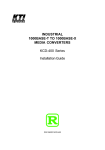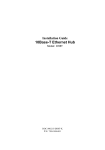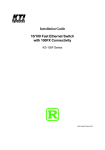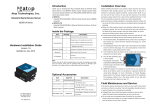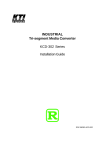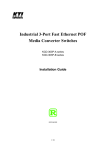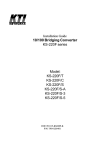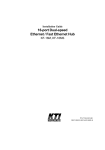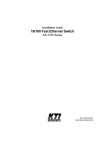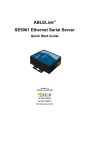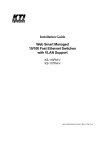Download KTI Networks KSC-200
Transcript
Industrial Serial RS-232 to Fiber Converter KSC-200 Series Installation Guide DOC.111209-KSC-200 -1- (C) 2006 KTI Networks Inc. All rights reserved. No part of this documentation may be reproduced in any form or by any means or used to make any directive work (such as translation or transformation) without permission from KTI Networks Inc. KTI Networks Inc. reserves the right to revise this documentation and to make changes in content from time to time without obligation on the part of KTI Networks Inc. to provide notification of such revision or change. For more information, contact: United States International KTI Networks Inc. P.O. BOX 631008 Houston, Texas 77263-1008 Phone: Fax: E-mail: URL: 713-2663891 713-2663893 [email protected] http://www.ktinet.com/ Fax: E-mail: URL: 886-2-26983873 [email protected] http://www.ktinet.com.tw/ -2- The information contained in this document is subject to change without prior notice. Copyright (C) All Rights Reserved. TRADEMARKS Ethernet is a registered trademark of Xerox Corp. FCC NOTICE This device complies with Class B Part 15 the FCC Rules. Operation is subject to the following two conditions: (1) This device may not cause harmful interference, and (2) this device must accept any interference received including the interference that may cause. CE NOTICE Marking by the symbol indicates compliance of this equipment to the EMC directive of the European Community. Such marking is indicative that this equipment meets or exceeds the following technical standards: EMC Class B EN55022:1998/A1:2000/A2:2003 Class B EN61000-3-2:2000 EN61000-3-3:1995/A1:2001 EN 55024:1998/A1:2001/A2:2003 IEC 61000-4-2:2001 IEC 61000-4-3:2002/A1:2002 IEC 61000-4-4:1995/A1:2000/A2:2001 IEC 61000-4-5:2001 IEC 61000-4-6:2003 IEC 61000-4-8:2001 IEC 61000-4-11:2001 -3- Table of Contents 1. Introduction ......................................................... 5 1.1 Features ........................................................................................ 6 1.2 Specifications ................................................................................ 7 2. Installation ......................................................... 11 2.1 Unpacking ..................................................................................... 11 2.2 Safety Cautions .......................................................................... 12 2.3 DIN-Rail Mounting ....................................................................... 13 2.4 Panel Mounting ............................................................................ 15 2.5 Applying Power ........................................................................... 17 2.6 Power Failure Relay Output ........................................................ 20 2.7 Making Serial RS-232 Connection .............................................. 20 2.7.1 RS-232 Port Pin Assignment Table ......................................... 21 2.7.2 Cable for Connection to PC COM Port ..................................... 22 2.8 Making Fiber Port Connection ..................................................... 23 2.9 Application ................................................................................... 25 3 LED Indicators ................................................... 26 3.1 LED Indicators ............................................................................. 26 Appendix: Model Optical Specifications ............ 27 -4- 1. Introduction The converter is designed to provide the most versatile connection possible between two RS-232 serial equipment using fiber optic cable. It allows any two pieces of serial equipment to communicate full-duplex over typical duplex fibers,or over optional single fiber up to 20km. The converter supports transparent conversion for not only RS-232 data lines, but also all RS-232 control signals. It also supports all RS-232 baud rates with no need for user configuration. The Din-rail mountable design makes it ideal for industrial cabinets and enclosures. For industrial environment, the converters are designed with the following enhanced features exceeding that of commercial media converters: • High and wide operating Temperature • Wide operating voltage range for DC power input • Power input interface: Industrial screw terminal block and DC power jack for external commercial power adapter as option • DIN rail mounting support for industrial enclosure • Screw panel mounting support for industrial enclosure • Industrial-rated Emission and Immunity performance -5- 1.1 Features z Transparent conversion for all RS-232 signals z Supports RS-232 baud rate higher than 115.2K bps z Auto adaptation and conversion to any RS-232 baud received z Operation with no required configuration z Extending all RS-232 signals over long optical cables z Supports versatile optical cables: -ST/SC multimode duplex fibers -SC single mode duplex fibers -SC single mode single fiber z Provides surge protection (transient voltage)on RS-232 signals z Provides high ESD protection on RS-232 signals z Provides optical isolation between RS-232 and main circuitry z Low power consumption z Two power interface type: screw terminal block and DC jack z Wide operating voltage input range z Support DIN rail mounting z Support panel mounting z High and wide operating temperature range z Industrial-rated Emission and Immunity performance -6- 1.2 Specifications This figure shows the important components of the device: -7- Serial Interface (RS-232 Port) Connector DB9 female Pin Assignments DCE type Isolation RS-232 I/O and internal system Baud Rate Support Auto-detect, Up to 120K Connector Shield Connect to chassis ground Connection Distance 15 meters High ESD Tolerance +/-15KV on Tx, Rx lines Overvoltage Protection Cutoff if over +/-25V Isolation Optical isolation from internal system Fiber Optic Interface (Fiber Port) Connector Duplex ST, Duplex SC, or Bi-Di SC Data Speed 100Mbps Duplex Mode Full duplex Cable Types MMF - 50/125, 62.5/125 SMF - 9/125 Link Distance MMF up to 2 km SMF -model dependent Eye Safety compliance IEC825 Class 1 Refer to Appendix for detailed optical specifications. LED Indicators LED DISPLAY PWR Power status TX RX FX LNK RS-232 Tx RS-232 Rx Optical status STATE ON OFF BLINK BLINK ON OFF -8- INTERPRETATION Power on Power off RS-232 Tx Activity status RS-232 Rx Activity status Fiber port optical signal detected Fiber port no optical signal DC Power Interface Interface Operating Input Voltages Power consumption Screw-type terminal block 1. Two pairs for power wire cascading 2. One pair for power failure relay output DC Jack (-6.3mm/+D2.0mm) +7V ~ +30V(+5%) 2.1W @+7.5VDC input 2.14W @+12.6VDC input 2.4W @+30VDC input Basic Information Conversion Transparent for all RS-232 signals Mechanical Dimension (base) Housing Mounting Support Weight W 28mm x D 82mm x H 95mm Enclosed metal with no fan DIN-rail mounting, Panel mounting 248g Environmental Operating Temperature Storage Temperature Relative Humidity Typical -30oC ~ 70oC (model dependent) -30oC ~ 85oC 5% ~ 90% -9- Certificate FCC CE/EMC CE/LVD Safety Part 15 Class B EMI EN50081-1 Class B EMS EN55024 EN 60950 EN55022 EN61000-3-2 EN61000-3-3 EN 55024 IEC 61000-4-2 IEC 61000-4-3 IEC 61000-4-4 IEC 61000-4-5 IEC 61000-4-6 IEC 61000-4-8 IEC 61000-4-11 ESD Test RS Test EFT/BURST Test Surge Test CS Test Magnetic Field Volatge Int. Dips -10- 2. Installation 2.1 Unpacking Check that the following components have been included: • Information CD • The device unit • DIN-rail mounting bracket If any item is found missing or damaged, please contact your local reseller for replacement. The following are available optional accessories: • Panel Mounting Bracket The bracket is used for mounting the device on a panel surface. • Commercial-rated AC power adapters: - Rated AC120V/60Hz DC7.5V 1A - Rated AC230V/50Hz DC7.5V 1A - Rated AC100V/50-60Hz DC7.5V 1A - Rated AC240V/50Hz DC7.5V 1A The adapters are used for supplying DC power to the converter via DC power jack interface. -11- 2.2 Safety Cautions To reduce the risk of bodily injury, electrical shock, fire, and damage to the equipment, observe the following precautions. • Do not service any product except as explained in your system documentation. • Opening or removing covers may expose you to electrical shock. Only a trained service technician should service components inside these compartments. • If any of the following conditions occur, unplug the product from the electrical outlet and replace the part or contact your trained service provider: - The power cable, extension cable, or plug is damaged. - An object has fallen into the product. - The product has been exposed to water. - The product has been dropped or damaged. - The product does not operate correctly when you follow the operating instructions. • Do not push any objects into the openings of your system. Doing so can cause fire or electric shock by shorting out interior components. • Operate the product only from the type of external power source indicated on the electrical ratings label. If you are not sure of the type of power source required, consult your service provider or local power company. -12- 2.3 DIN-Rail Mounting In the product package, a DIN-rail bracket is installed on the device for mounting the converter in a industrial DIN-rail enclosure. The steps to mount the device onto a DIN rail are: 1. Install the mounting bracket onto the device unit as shown below: 2. Attach bracket to the lower edge of the DIN rail and push the unit upward a little bit until the bracket can clamp on the upper edge of the DIN rail. 3. Clamp the unit to the DIN rail and make sure it is mounted securely. 4. Make sure that there are proper heat dissipation from and adequate ventilation around the device. -13- The final mechanical dimensions after installing DIN rail mounting bracket are: -14- 2.4 Panel Mounting The device is provided with an optional panel mounting bracket. The bracket support mounting the device on a plane surface securely. The mounting steps are: 1. Install the mounting bracket on the device unit. 2. Screw the bracket on the device unit. 3. Screw the device unit on a panel. 4. Make sure that there are proper heat dissipation from and adequate ventilation around the device. Do not place heavy objects on the device. -15- The screw locations and final dimension are shown below: -16- 2.5 Applying Power The power specifications of the device are: Operating Voltage +7 ~ +30VDC Power Consumption Max. 2.4W @30VDC The device provides two types of power interfaces, terminal block and DC power jack for receiving DC power input from external power supply. Using Terminal Blocks Either DC1 interface or DC2 interface can be used to receive DC power from an external power system. Or, DC2 also can be used to deliver the power received on DC1 to next device in cascading way. DC1 + Vdc Positive (+) terminal DC1 - Vdc Negative (-) terminal DC2 + Vdc Positive (+) terminal DC2 - Vdc Negative (-) terminal Three 2P terminal plugs are provided together with the device. Two of the three plugs are used for DC1 and DC2 interfaces respectively. The plug is shown below: -17- Power wires: 24 ~ 12AWG (IEC 0.5~2.5mm2) Install the power source wires with the plug properly. Screw the wire with plug securely. Then, plug in DC1 contacts. If cascading the power to next device is needed, install the power wires and plug for another switch. Then, use DC2 contacts. Note: Only up to four device units can be cascaded to receive power from one main power input source. -18- Using DC Power Jack DC Jack Connector: Jack D 6.3mm D 2.0mm AC Power Adapters: Optional commercial rated adapters are available for purchasing. Rated AC120V/60Hz DC7.5V 1A Rated AC230V/50Hz DC7.5V 1A Rated AC100V/50-60Hz DC7.5V 1A Rated AC240V/50Hz DC7.5V 1A Connect power adapter DC plug to the DC power jack of the converter before connecting to the AC outlet. Connect the power adapter to the AC outlet. Note: Before you begin the installation, check the AC voltage of your area. The AC power adapter which is used to supply the DC power for the unit should have the AC voltage matching the commercial power voltage in your area. -19- 2.6 Power Failure Relay Output The device provides a relay output to report power failure event to a remote alarm monitoring system. The replay output is provided with two contacts labeled PF+ and PF- in the terminal block interface. Use the provided 2P terminal plug for signal wiring and plug into the PF+/ - contacts. The function is designed as : Power is normal PF+ contact is shorted with PF- contact. Power failure PF+ contact is disconnected with PF- contact. Note: Be sure the voltage applied on PF+/- contacts is within the specification of 30VDC/1A max. or 120VAC/0.5A max. 2.7 Making Serial RS-232 Connection -20- 2.7.1 RS-232 Port Pin Assignment Table Pin# 1 2 3 4 5 6 7 8 9 Signal Name Input/Output Received Line Signal Detect Output TX Data Output RX Data Input DTE Ready Input Signal Ground Output DCE Ready Output Clear To Send Input Request To Send Output Ring Indicator Output -21- 2.7.2 Cable for Connection to PC COM Port Connecting to 9-pin DTE device (Computer or PC COM) Connecting to 25-pin DTE device (Computer or PC COM) -22- 2.8 Making Fiber Port Connection Depending on the model purchased, the fiber port provides one of the following connector types: Duplex ST, Duplex SC, Single SC. Connecting Multimode Duplex Fiber Make sure the RX-to-TX connection rule is followed on the both ends of the fiber cable. Connecting Single Mode Duplex Fiber Note: Make sure the RX-to-TX connection rule is followed on the both ends of the fiber cable. -23- Connecting Single Mode Single Fiber For Bi-Di (Bidirectional) single fiber connection which use two different wavelengths for TX and RX respectively over single SM fiber cable, only one connector is provided on the fiber port and only one fiber cable is used. Network Cables Multimode (MMF) - 50/125, 62.5/125 Single mode (SMF) - 9/125 Fiber Distance between two devices Model Connector Fiber KSC-200-T ST MMF Distance (ref. max.) 2km KSC-200-C SC MMF 2km KSC-200-SL2 SC SMF 20km KSC-200-SL4 SC SMF 40km KSC-200-SL6 SC SMF 60km KSC-200-W3515 Bi-Di SC Single SMF Tx 1310nm Rx 1550nm 15~20km KSC-200-W5315 Bi-Di SC Single SMF Tx 1550nm Rx 1310nm 15~20km Note: KSC-200-W3515 and KSC-200-W5315 must be connected together as a pair on both ends of the single fiber. For other longer distances, consult your dealer for more information. -24- 2.9 Application The converter can be used to extend the distance between two serial devices via fiber cables. The distance can be 2km, 20km, and even up to 100km. The following example illustrates a PC performs serial communocation with another RS-232 device far apart: The converter converts all signals of the COM port of the PC to optical signals and sends to the other converter far apart over fiber cable. -25- 3 LED Indicators The following figure shows the locations of the LED indicators: 3.1 LED Indicators LED PWR DISPLAY Power status STATE ON OFF INTERPRETATION The device is powered on. The device is powered off. 232 TX RS-232 TX ON OFF RS-232 TX data is present No RS-232 TX data 232 RX RS-232 RX ON OFF RS-232 RX data is present No RS-232 RX data FX LNK Fiber port link ON OFF Fiber port optical signal detected Fiber port no optical signal -26- Appendix: Model Optical Specifications Model Fiber Port Specifications Model FX Wavelength Tx Power Sensitivity Max.Rx 200-T ST 1310nm -20~-14 -32dBm -8dBm 200-C SC 1310nm -20~-14 -31dBm 0dBm 200-SL2 SC 1310nm -15~-7 -30dBm -7dBm 200-SL4 SC 1310nm -5~ 0 -34dBm 0dBm 200-SL6 SC 1310nm -5~ 0 -35dBm 0dBm 200-W3515 BiDi SC Tx 1310nm -14~-8 -31dBm 0dBm -14~-8 -31dBm 0dBm Rx 1550nm 200-W5315 BiDi SC Tx 1550nm Rx 1310nm -27-



























